A recent study has revealed that ocean surface waves, triggered by tropical cyclones (TC), have been intensifying over time, raising future concerns. The study found that both the peak height of these waves and the area they cover have seen a significant surge, with these changes surpassing those of the TC’s maximum wind speed.
The Nature Communications journal published the research, which scrutinized 43 years’ worth of data on global trends in TC-induced ocean surface waves, on January 3, 2024.
Tropical cyclones, which include hurricanes and typhoons, are warm-core low-pressure systems that form over tropical or subtropical waters and exhibit organized circulation. They generate high winds, large waves, extreme water levels, and heavy rainfall.

According to the paper, the maximum height and the area of these wave footprints have globally risen by approximately 3% and 6% per decade, respectively. The energy of these waves, transferred from the atmosphere to the ocean at the interface, has globally escalated by about 9% per decade. This rate is triple that reported for all waves.
Research observed the North Atlantic, eastern Pacific, and North Indian Ocean exhibiting the most rapid increases in TC wave footprint (17-32% per decade). The researchers primarily attribute the expanding wave area to the rising trend of global wave energy.
The study also noted a significant long-term increase in the maximum wave height across all ocean basins, with the North Atlantic witnessing the largest increase of 5% per decade.
Cyclones intensify, impact climate and economy
Tropical cyclones (TCs) are crucial in maintaining the balance of energy at the interface between air and sea. They absorb heat energy from the ocean surface to fuel their growth, while also releasing kinetic energy into the ocean via waves.
A study led by Jian Shi from Hohai University, China, examined the global trends of tropical cyclone waves from 1979 to 2022, using the ERA5 wave reanalysis. ERA5 is the fifth-generation atmospheric reanalysis of the global climate by the European Centre for Medium-Range Weather Forecasts, providing hourly estimates of numerous atmospheric, land, and oceanic climate variables from January 1940 to the present.
Tropical Cyclone Freddy, a long-lasting tropical system, traversed the Indian Ocean and severely affected Madagascar, Mozambique, and parts of southeast Africa with heavy rain and flooding. After a record-breaking 37-day journey over the southern Indian Ocean and Africa, Freddy dissipated over Malawi on March 15, 2023.
Research discovered that tropical cyclones induce ocean turbulence that reaches deeper than previously believed, leading to a mixing process that transfers heat from the surface to waters nearly 300 metres deep.
The researchers proposed that the ocean warming induced by tropical cyclones is profound enough to last for months or years and can travel far from its origin, potentially modifying the broader patterns of ocean circulation that partially control Earth’s climate.
TCs inflict extensive damage through strong winds and heavy rainfall, leading to destructive oceanic extremes such as storm surges and surface waves. This poses a significant threat to infrastructure, navigation, and communities. Intense tropical cyclones can hinder a country’s economic development.
Keep Reading
Part 1: Cloudburst in Ganderbal’s Padabal village & unfulfilled promises
India braces for intense 2024 monsoon amid recent deadly weather trends
Support us to keep independent environmental journalism alive in India.
Follow Ground Report on X, Instagram and Facebook for environmental and underreported stories from the margins. Give us feedback on our email id greport2018@gmail.com.
Don’t forget to Subscribe to our weekly newsletter, Join our community on WhatsApp, and Follow our YouTube Channel for video stories.








